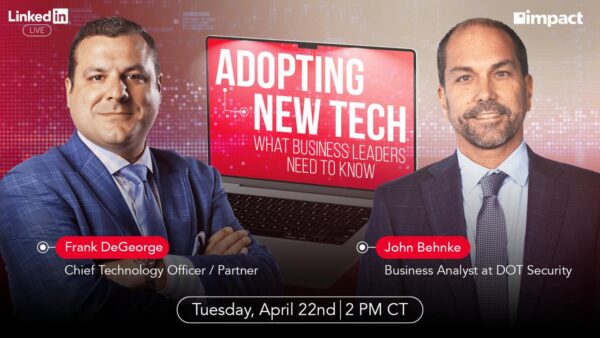Strategies for unlocking growth opportunities in IT services.
For office technology dealers accustomed to leasing and servicing traditional imaging equipment like MFPs and printers, adding IT services offerings requires a mind shift. There are the go-to-market considerations to address, for sure. However, two executives whose dealerships have experienced great success as managed service providers (MSPs) within the imaging channel also recommend exercising patience, maintaining focus, and staying invested.
According to Patrick Layton, president/partner of managed IT services at 25-year-old Impact Networking in Lake Forest, Illinois, migration away from the conventional commoditization model may be the biggest cultural challenge within dealer organizations. As obvious as it may sound, selling managed IT services differs from selling print-related services. In Layton’s view, IT services requires more consultation.
Multiple Options for Building a Managed IT Business
However, before tackling that change in approach, here’s a more pressing question: How do you want to venture into the infotech realm? “Buying an established company is the fastest route,” noted Layton, adding that acquisitions today are a more expensive proposition than a decade ago because there is more private equity money in the space.
Organically building the business by yourself is another method used for IT onboarding. In this scenario, there are partners involved but no outsourcing. When the Impact Networking team hired Layton nearly 11 years ago, he was charged with starting the MSP business unit. In the 10 years since, the dealership’s client base has grown from zero to some 425 managed service accounts representing $105 million in revenue annually, accounting for nearly half of its $215 million total in 2024.
The third IT alternative is a hybrid approach where you bring in a VCIO [virtual chief information officer] to consult, add a handful of engineering resources, and then outsource to a managed IT services partner. According to Layton, this in-between model is popular among smaller dealers.
Ray Vrabel, who works for ConnectWise, a software company that works closely with IT solution providers, agreed with Layton’s build-partner-buy breakdown. “Partnering is the faster go-to-market option,” said Vrabel, who counts building out help desks among his two decades of tech experience. Now director of the software firm’s Senior Partner Program, he came to ConnectWise five years ago via acquisition from former competitor Continuum.
These days, the meaning of MSP has become so vague that practically anyone can set up managed service operations. “All they need is a website, which can be charged to a credit card,” observed Dustin Bonn, VP of IT operations for Minnesota-based mega dealer Marco. “Not everyone charges $200 to $500 per user per month. Smaller MSPs may only be set up for monitoring and charge every time they fix something,” he explained.
Shopping for their second, third, or even fourth MSP, today’s buyers are well-versed, added Bonn. Most are equipped with keen “sniffers” that can quickly detect the difference between a pop-up provider and a more legitimate operation taking on, say, 10,000 tickets per month.
“It has become a crowded space . . . [because] the barrier to entry is much less than in the past,” noted Bonn. A software partner may bring its remote monitoring and management (RMM) platform to the table, but “having tools is only one aspect,” he stressed. It’s not the same as having all the processes and people in place – not to mention attracting customers. “Reaching operational maturity is more complex than ever,” warned the 13-year Marco veteran who came from a value-added reseller environment. High technical aptitudes and regulatory knowledge are required, and “most dealers don’t have that kind of talent on the bench.”
Someone to Lean On
Many dealerships tend to lean more heavily on their partners early in the process—from vetting technicians to evaluating staff. “The prospect of managing multiple networks can be intimidating,” acknowledged Vrabel. By bringing their platform and back-end support, a vendor partner such as ConnectWise can ease the daunting task of managing multi-tenant relationships, which takes on new meaning when there are hundreds of customers as opposed to 10 or 40. To be profitable, IT services visibility needs to deliver at scale.
Forging a partnership allows the dealer to offload numerous functions and not worry as much about VCIO considerations. “NOC/SOC, help desk, and incident-response teams are all in place, so you literally can start up tomorrow,” said Vrabel. ConnectWise, which refers to this as instant operational capacity and capability, strongly advocates the flexibility of a pay-as-you-go/grow partner model. Its proprietary partner portal even offers white-label marketing programs and webinars-in-a box.
The IT services upside is that multinetwork management is easier than ever before. More and more server stacks now reside in the cloud, and today’s interfaces feature proactive alerting and easily toggle between clients. “Microsoft takes care of the backend stuff,” said Layton. “With proper documentation and the right tools, network management is not the biggest lift.”
For dealers going it alone and building the new practice organically, ConnectWise’s Vrabel recommends looking intently at staff to see who might gravitate naturally to the IT side. “Some people have grown tired of selling only print,” he said, “but selling managed services and data protection, along with print, might be more appealing.” The challenge is to get sales team members excited about approaching their dentist, doctor, lawyer, and car dealership customers about the broader range of services now available.
Who Are You?
Once you’ve decided how to go about the IT services quest, answering the next question could be the key to success: What type of MSP do you want to be? Define your ideal target. Should you cast for the five-to-20-unit clientele or wade upstream for bigger fish in the mid-market segment? Should you limit engagement to help-desk firewall installations, or widen your net into more of a project strategy and sell hardware, too?
Some MSPs have no boots on the ground; others leverage pain points and chase enterprise prospects with low-level, niche services. “I know of IT companies that make a good living by only focusing on patch and vulnerability, which nobody wants to deal with themselves,” said Layton. So, decide whatever it is that you want to be in this space, he tells dealers, and then build a model around it.
Crime Pays
Security services need to be part of your IT services equation. Per multiple reports, cybercrime is expected to exceed $10 trillion this year. Layton recalls that hackers and so-called threat actors raked in half that amount five years ago. The massive increase explains why 50% of Impact Networking’s MSP deals now have cybersecurity built in. “Soon, it won’t be optional,” Layton predicted. “Businesses are at risk, and our industry is changing to a true security-first model.” For Marco, computer security services represent at least 25% of IT revenues.
The dealer executives won’t get an argument from ConnectWise regarding the topic of criminology. “Cybersecurity has seen massive growth,” agreed Vrabel. “Over the past five to seven years, it has become a centerpiece.” Indeed, covering the basics of anti-virus protection, more robust firewalls, and malware remediation are not enough anymore. “Now, we sell uptime and data availability,” he said. “Keeping the bad guys out is all about protection, detection, and responding to alerts.”
As of January 1, 2025, vulnerability management became front and center for Impact Networking’s security framework: an action driven largely by business insurers. For the company’s own protection, cybersecurity insurance is required with all customer contracts. “We will waive it for the first six months, but then the customer has to get a policy,” emphasized Layton.
Impact Networking includes six security operations center (SOC) services in every managed IT deal. (All services provide telemetry back to the firm’s 24×7 SOC.)
- EDR/MDR (endpoint detection & response and managed detection & response) backed by the SOC at spinoff company DOT Security
- Endpoint persistence detection
- Endpoint DNS (domain name system) protection
- Firewall investigation service
- Email investigation service
- SEIM (security event and incident management) for Microsoft 365
Nobody wants to deal with security issues, but Layton acknowledged that client data will probably be breached somehow. “If there is a plan in place—and they work that plan—the recovery cost can be mitigated,” he added.
What’s IT Services Cost?
Staffing allocations, experience evaluations, and client readiness are some variables that make it difficult for dealerships to estimate IT services business implementation costs. “The talent you hire is your number one expense,” said Layton. His rule of thumb assumes an average of $100,000 per employee. High-level engineers (with Microsoft Azure, Google Cloud, and Amazon Web expertise) could command twice that annual salary. So, for a 10-person operation, you’re looking at roughly $1 million in startup costs.
Marco’s Bonn concurred that investing in human capital, which he calls the “builders,” is essential to MSP success. “More automation and the digitally led customer experience can come later,” he noted.
While $1 million may seem like a lot of money to lay out upfront, ROI is on the IT services horizon. “Per-unit pricing adds up,” according to Layton, “and profits can come quickly.” Even in a small-business context, charging monthly rates of $2,000 for 20 end-users means only 42 clients are needed to break even that first year. “It’s not that expensive to buy tools,” he added, which can be purchased month-to-month using a credit card.
Whichever onboarding methodology is chosen (to build, buy, or partner), implement and execute it correctly. Risk is inherent, and there are stories of dealers who have tried and failed to get into the IT game. According to Vrabel, their main hindrance is not doing the prep work to understand everything that’s entailed.
“If service delivery is poor, what happens is that client relationships often turn sour,” Vrabel cautioned, adding that dealer employees can get unsavory tastes in their proverbial mouths, too. Not surprisingly, after being burned by bad experiences, some sales reps won’t touch IT services.
That’s why Bonn believes partnering is the most effective of the three IT entry options. He suggested seeking out someone with whom you can develop an alliance and do lead sharing. His most important advice to fellow dealers is not to be something they can’t be. “Start small and grow it from there,” Bonn said, adding that a micro-niche approach may be the best way to begin. Some dealerships new to IT have narrowed their focus within a given vertical market. For example, they may zero in on ambulatory service providers within the healthcare marketplace, then, after a year or two, expand their scope and size.
The ability to adapt and pivot is key, even for a big dealer like Marco, which manages more than 30,000 endpoints nationally. In 2025, the firm’s compass is pointing toward more subject matter expertise. “Customers keep asking to do more inside their own software,” revealed Bonn. So, from application building and digital transformation to governmental regulations and artificial intelligence, its internal trend is to improve within vertical markets such as finance and healthcare.
Is your dealership willing to go all the way in on IT services? Depending on the level of investment, there may or may not be a long-term struggle. The cultural cornerstone for dealer owners and managers is to embrace the business model shift, advised Vrabel. A final word to the wise: “IT is not just another SKU,” he stressed. “You cannot simply dip a toe into the water. To make it work, you need to commit.”



